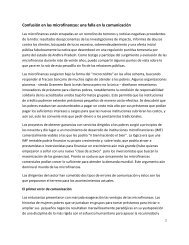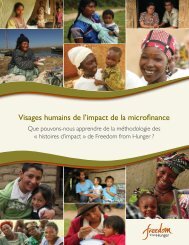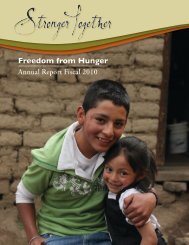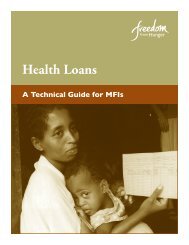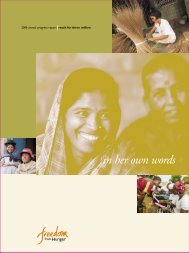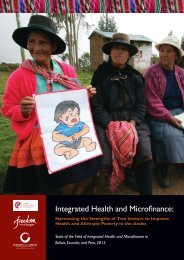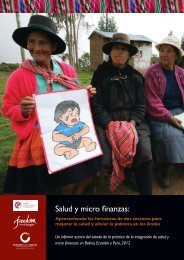Strengths, Weaknesses and Evolution of the Peace Corps' 11-Year ...
Strengths, Weaknesses and Evolution of the Peace Corps' 11-Year ...
Strengths, Weaknesses and Evolution of the Peace Corps' 11-Year ...
Create successful ePaper yourself
Turn your PDF publications into a flip-book with our unique Google optimized e-Paper software.
1. Introduction<br />
1.1 History <strong>of</strong> <strong>the</strong> Programa de Ahorro y Crédito (PAC)<br />
In 1999, <strong>Peace</strong> Corps Ecuador adapted <strong>the</strong> community banking program implemented by<br />
CARE Niger called Mata Masu Dubara (Women Moving Ahead). The community banking<br />
manual from Niger was translated from French to Spanish, <strong>and</strong> seven <strong>Peace</strong> Corps volunteers <strong>and</strong><br />
<strong>the</strong>ir counterparts as well as three Ecuadorian national volunteers were trained on <strong>the</strong> methodology.<br />
After eight months, <strong>the</strong>y had formed ten banks with $2,500 in accumulated savings.<br />
After <strong>the</strong> pilot, <strong>Peace</strong> Corps began conducting at least two trainings per year with <strong>Peace</strong> Corps<br />
volunteers <strong>and</strong> <strong>the</strong>ir counterparts. The goal <strong>of</strong> PAC is to create self-managed, sustainable<br />
community banks where members can save, access loans, generate interest on <strong>the</strong>ir savings <strong>and</strong><br />
engage in income-generation <strong>and</strong> community development activities.<br />
Initially, <strong>Peace</strong> Corps volunteers from <strong>the</strong> four program areas <strong>of</strong> agriculture, environment, health<br />
<strong>and</strong> youth were involved in PAC. More recently, <strong>the</strong> agriculture program volunteers have been most<br />
involved in part because <strong>of</strong> <strong>the</strong> funding source <strong>and</strong> <strong>the</strong> fact that <strong>the</strong> manager <strong>of</strong> <strong>the</strong> agriculture<br />
program has also managed PAC. PAC helps to achieve one <strong>of</strong> <strong>the</strong> goals <strong>of</strong> <strong>the</strong> <strong>Peace</strong> Corps<br />
agriculture program: promoting agro-business.<br />
The PAC intends to reach rural communities <strong>and</strong> low-income populations. <strong>Peace</strong> Corps estimates<br />
that approximately 80% <strong>of</strong> <strong>the</strong> participants in <strong>the</strong> program are women. <strong>Peace</strong> Corps believes<br />
<strong>the</strong> program functions better with women because <strong>the</strong>y invest in <strong>the</strong>ir families.<br />
Currently <strong>the</strong>re are 200 <strong>Peace</strong> Corps volunteers in Ecuador, approximately 30 <strong>of</strong> whom are working<br />
with community banks. Given <strong>the</strong> withdrawal <strong>of</strong> <strong>Peace</strong> Corps volunteers from communities after<br />
<strong>the</strong>ir two-year service <strong>and</strong> <strong>the</strong> spontaneous spread <strong>of</strong> community banks, it has been difficult for<br />
<strong>Peace</strong> Corps to maintain contact with community banks. In addition, <strong>Peace</strong> Corps does not have a<br />
formal monitoring system in place for <strong>the</strong> PAC.<br />
However, given <strong>the</strong> contacts it has in <strong>the</strong> communities, <strong>Peace</strong> Corps estimates <strong>the</strong>re are<br />
approximately 50,000 members in 1,500 community banks in Ecuador. The majority <strong>of</strong> <strong>the</strong><br />
community banks are located in <strong>the</strong> coastal regions, including Chone, Bahía de Caráquez <strong>and</strong> Santa<br />
Elena <strong>and</strong> in Loja in <strong>the</strong> Andes. <strong>Peace</strong> Corps suspects that <strong>the</strong>re are fewer community banks in <strong>the</strong><br />
Andes because <strong>of</strong> a more risk-averse culture, fewer appropriate activities for community banking<br />
such as agriculture in <strong>the</strong> Andes vs. commerce on <strong>the</strong> coast, <strong>and</strong> <strong>the</strong> lesser likelihood <strong>of</strong> <strong>the</strong><br />
populations in <strong>the</strong> Andes to go out at night due to <strong>the</strong> cold wea<strong>the</strong>r.<br />
In addition to <strong>the</strong> PAC in Ecuador, <strong>Peace</strong> Corps Ecuador has conducted PAC trainings with<br />
<strong>Peace</strong> Corps Dominican Republic where <strong>the</strong>re are currently 200 community banks;<br />
<strong>Peace</strong> Corps Nicaragua where <strong>the</strong>re are 400 community banks;<br />
<strong>Peace</strong> Corps Peru; <strong>and</strong><br />
one organization in Mexico.<br />
<strong>Strengths</strong>, <strong>Weaknesses</strong> <strong>and</strong> <strong>Evolution</strong> <strong>of</strong> <strong>the</strong> <strong>Peace</strong> Corps’ <strong>11</strong>-<strong>Year</strong>l-Old Savings Group Program in Ecuador P a g e | 1



